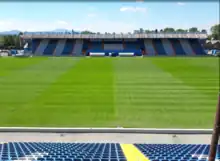Varaždin
Varaždin (Croatian pronunciation: [ʋâraʒdiːn] or [ʋarǎʒdin]; Hungarian: Varasd, also known by other alternative names) is a city in Northern Croatia, 81 km (50 mi) north of Zagreb. The total population is 46,946, with 38,839 on 34.22 km2 (13.21 sq mi) of the city settlement itself (2011).[3] The centre of Varaždin County is located near the Drava River, at 46.312°N 16.361°E. It is mainly known for its baroque buildings, music,[4] textile, food and IT industry.[5]
Varaždin | |
|---|---|
| Grad Varaždin City of Varaždin | |
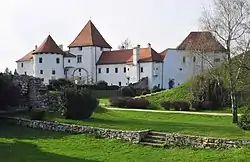 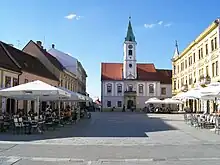 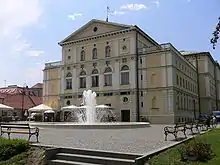  Top: Varaždin Castle; Center left: Korzo; Center right: Croatian National Theater; Bottom: Varaždin Arena | |
 Flag  Coat of arms | |
| Motto(s): Probitati et bonis artibus (English: For Honesty and Good Virtues) | |
 Varaždin Location of Varaždin within Croatia | |
| Coordinates: 46°18′29″N 16°20′16″E | |
| Country | |
| County | |
| Government | |
| • Mayor | Neven Bosilj (SDP) |
| • City Council | 21 members |
| Area | |
| • City | 59.9 km2 (23.1 sq mi) |
| • Urban | 34.5 km2 (13.3 sq mi) |
| Elevation | 173 m (568 ft) |
| Population (2021)[2] | |
| • City | 43,782 |
| • Density | 730/km2 (1,900/sq mi) |
| • Urban | 36,187 |
| • Urban density | 1,000/km2 (2,700/sq mi) |
| Time zone | UTC+1 (CET) |
| • Summer (DST) | UTC+2 (CEST) |
| Postal code | HR-42 000 |
| Area code | +385 42 |
| Vehicle registration | VŽ |
| Patron saints | St. Nicholas |
| Website | varazdin |
Name
In Hungarian the town is known as Varasd, in Latin as Varasdinum and in German as Warasdin. The name Varaždin traces its origin in the word varoš, a Hungarian loanword meaning city.[6]
Population
The total population of the city is 46,946 and it includes the following settlements:[3]
- Črnec Biškupečki, population 696
- Donji Kućan, population 716
- Gojanec, population 620
- Gornji Kućan, population 1,139
- Hrašćica, population 1,283
- Jalkovec, population 1,309
- Kućan Marof, population 1,388
- Poljana Biškupečka, population 452
- Varaždin, population 38,839
- Zbelava, population 504
The total area is 59.45 km2 (22.95 sq mi) (2001).
| population | 11560 | 12188 | 12116 | 13021 | 14931 | 16925 | 17441 | 17112 | 21602 | 23743 | 31243 | 39383 | 45844 | 48834 | 49075 | 46946 | 43782 |
| 1857 | 1869 | 1880 | 1890 | 1900 | 1910 | 1921 | 1931 | 1948 | 1953 | 1961 | 1971 | 1981 | 1991 | 2001 | 2011 | 2021 |
History
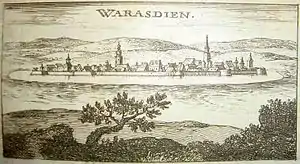
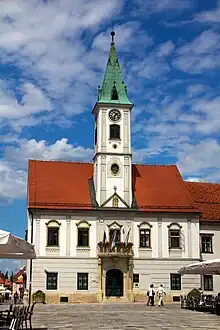
The first written reference to Varaždin, whose historical name is Garestin, was on 20 August 1181, when King Béla III mentioned the nearby thermal springs (Varaždinske Toplice) in a legal document.[7]
Varaždin was declared a free royal borough in 1209 by the Hungarian King Andrew II. The town became the economic and military centre of northern Croatia. Due to Ottoman raids, the town was structured defensively around the old fortress, and acquired the shape of a typical medieval Wasserburg. In the early 13th century, the Knights Hospitaller (Croatian: Ivanovci) came to Varaždin, where they built the church and a monastery.[7]
At the end of the 14th century, Varaždin fortress passed to the hands of the Counts of Celje. Over the following centuries Varaždin had several owners, the most influential being Beatrice Frankopan, wife of Margrave Georg of Brandenburg-Ansbach, who built the town hall; the last was Baron Ivan Ungnad, who reinforced the existing fortification. At the end of the 16th century Count Thomas Erdődy became its owner, assuming the hereditary position of Varaždin prefects (župan), and the fortress remained in the ownership of the Erdődy family until 1925.
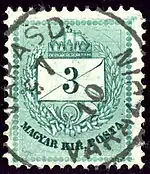
In 1756, the Ban Ferenc Nádasdy chose Varaždin as his official residence, and Varaždin became the capital of all of Croatia. It hosted the Croatian Sabor and the Royal Croatian Council founded by Empress Maria Theresa.
The periods of the Reformation and the counter-reformation had a great influence on Varaždin. With the arrival of the Jesuits, the school (gymnasium) and the Jesuit house were founded, and churches and other buildings were built in the Baroque style. In the 18th century Varaždin was the seat of many Croatian noblemen, and in 1756 it became the Croatian administrative centre. The fire of 1776 destroyed most of the town, resulting in the administrative institutions moving back to Zagreb.[7]
Varaždin was the seat of Varaždin County of the Kingdom of Croatia-Slavonia within the Austro-Hungarian monarchy, ruled by the Kingdom of Hungary after the compromise of 1867. The Hungarian stamp, issued in 1881 shows both names.
By the 19th century Varaždin had been completely rebuilt and expanded, with flourishing crafts and trade, and later the manufacture of silk and bricks. The theatre, music school, and fire department were founded.
In the 20th century Varaždin developed into the industrial centre of Northwestern Croatia. The textile manufacturer Tivar was founded in 1918. On 12 July 1941, Varaždin was declared Judenfrei by the Ustaše, becoming the first city in Croatia to earn this dubious distinction.[8] In the Croatian War of Independence, 1991, Varaždin suffered directly for only for a few days, because the huge Yugoslav People's Army base quickly surrendered, resulting in a minimal number of casualties, and providing weapons (worth $600m) for the Croatian army.
Monuments and sights
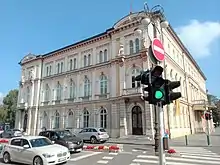
Varaždin represents the best preserved and richest urban complex in continental Croatia.

The Old Town (fortress) is an example of medieval defensive buildings. Construction began in the 14th century, and in the following century the rounded towers, typical of Gothic architecture in Croatia, were added. Today it houses the Town Museum. The fortress was depicted on the reverse of the Croatian 5 kuna banknote, issued in 1993 and 2001.[9]
The Old and Contemporary Masters Gallery is located in the Sermage Palace, built in the rococo style in 1750.
In 1523, Margrave Georg of Brandenburg built the town hall in late baroque style, with the Varaždin coat of arms at the foot of the tower, and it has continued in its function until the present day. There is a guard-changing ceremony every Saturday.
Varaždin's Cathedral, a former Jesuit church, was built in 1647, and is distinguished by its baroque entrance, eighteenth-century altar, and paintings.
There are many baroque and rococo palaces and houses in the town. Worth particular mention is Varaždin's Croatian National Theatre, built in 1873 and designed by the Viennese architects Herman Helmer and Ferdinand Fellner.
A baroque music festival has been held annually in Varaždin since 1971, and attracts some of the finest musicians and their fans from Croatia and the world. Recommended to visitors is also the historical street festival Špancir fest every August.
The city features its old city guard, named Purgari, in various city ceremonies as well as the weekly ceremony of the 'change of the guards' in front of the city hall. Additionally, Varaždin police officers patrol on bicycles in the warmer months.[10]
The Old Town (Stari Grad)
The Old Town keep is one of the biggest monuments in the city of Varaždin and one of its biggest tourist attractions. It is located in the north-western section of the city core. Today the keep houses the Varaždin City Museum.
The keep is first mentioned in the 12th century and it is believed to be the center of Varaždin county life. The keep underwent numerous ownership changes and reconstructions over the centuries. The Old Town was featured on the now defunct 5 Kuna bill.
Churches and monasteries
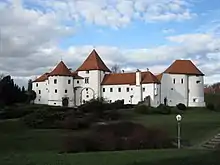
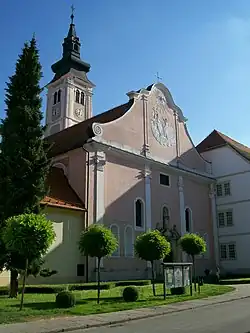
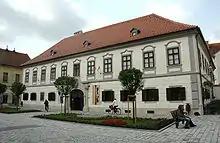
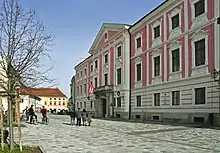
|
|
Baroque palaces
|
Varaždin cemetery
The cemetery dates back to 1773 and it was long time an ordinary place until 1905, when Herman Haller had an idea to make it more park-like with large trees and alleys for citizens to stroll through. The reconstruction of the cemetery was done between 1905 and 1947, and its current landscape and architecture dates from these works, It is now a protected cultural and natural park.
Festivals
- Špancirfest
- Varaždin Baroque Evenings
- International Children and Youth Animation Film Festival VAFI, since 2010[11]
Museums
- THE OLD TOWN (STARI GRAD) Museum houses the Cultural and Historic Collection. The Old Town Museum has been a part of the Varaždin City Museum organization since 1925. Today is features: over 400 pieces from the glass, ceramics and clocks collection, 10 rooms furnished in chronological period style (renaissance, baroque, rococo, Empire, Biedermeier, historicism and art deco), a chapel and sacristy, and 2 rooms dedicated to two prominent men from Varaždin, Vatroslav Jagić and Ivan Kukuljević Sakcinski.
- THE HERZER PALACE houses the Entomological Collection focusing on The World of Insects. There are over 4500 exhibits which clearly show the biology of bugs through several topics:In the forest, Near the forest and on the meadow, In the water and near the water, At night and underground.
- THE SERMAGE PALACE houses the Gallery of Old and Contemporary Masters Art Gallery. It is home to over 5300 works of art separated in 10 collections with works ranging from the 15th to the 20th century.
Climate
Varaždin has a warm-summer humid continental climate (Köppen climate classification Dfb) bordering on a maritime climate (Cfb).
| Climate data for Varaždin (1971–2000 normals, 1949–2014 extremes) | |||||||||||||
|---|---|---|---|---|---|---|---|---|---|---|---|---|---|
| Month | Jan | Feb | Mar | Apr | May | Jun | Jul | Aug | Sep | Oct | Nov | Dec | Year |
| Record high °C (°F) | 19.1 (66.4) |
21.6 (70.9) |
25.3 (77.5) |
30.4 (86.7) |
33.2 (91.8) |
36.0 (96.8) |
39.3 (102.7) |
39.4 (102.9) |
32.9 (91.2) |
27.7 (81.9) |
24.3 (75.7) |
21.4 (70.5) |
39.4 (102.9) |
| Average high °C (°F) | 3.4 (38.1) |
6.1 (43.0) |
11.1 (52.0) |
15.7 (60.3) |
20.9 (69.6) |
23.9 (75.0) |
26.0 (78.8) |
25.8 (78.4) |
21.5 (70.7) |
15.5 (59.9) |
8.6 (47.5) |
4.4 (39.9) |
15.2 (59.4) |
| Daily mean °C (°F) | −0.2 (31.6) |
1.6 (34.9) |
5.8 (42.4) |
10.3 (50.5) |
15.4 (59.7) |
18.5 (65.3) |
20.2 (68.4) |
19.5 (67.1) |
15.4 (59.7) |
10.0 (50.0) |
4.6 (40.3) |
1.0 (33.8) |
10.2 (50.4) |
| Average low °C (°F) | −3.7 (25.3) |
−2.5 (27.5) |
1.0 (33.8) |
4.7 (40.5) |
9.2 (48.6) |
12.6 (54.7) |
14.1 (57.4) |
13.5 (56.3) |
10.0 (50.0) |
5.5 (41.9) |
1.0 (33.8) |
−2.2 (28.0) |
5.3 (41.5) |
| Record low °C (°F) | −26.8 (−16.2) |
−28 (−18) |
−23.4 (−10.1) |
−5.5 (22.1) |
−2.3 (27.9) |
2.2 (36.0) |
4.7 (40.5) |
3.2 (37.8) |
−3.1 (26.4) |
−7.5 (18.5) |
−19.6 (−3.3) |
−22.7 (−8.9) |
−28 (−18) |
| Average precipitation mm (inches) | 38.9 (1.53) |
42.0 (1.65) |
50.9 (2.00) |
63.1 (2.48) |
71.8 (2.83) |
96.5 (3.80) |
91.2 (3.59) |
88.0 (3.46) |
84.7 (3.33) |
80.6 (3.17) |
77.0 (3.03) |
58.3 (2.30) |
843.1 (33.19) |
| Average precipitation days (≥ 0.1 mm) | 9.2 | 9.3 | 10.9 | 12.9 | 13.2 | 14.0 | 12.1 | 10.9 | 10.3 | 10.4 | 11.1 | 11.2 | 135.4 |
| Average snowy days (≥ 1.0 cm) | 13.5 | 9.9 | 3.4 | 0.5 | 0.0 | 0.0 | 0.0 | 0.0 | 0.0 | 0.0 | 3.7 | 9.4 | 40.4 |
| Average relative humidity (%) | 84.1 | 78.6 | 73.2 | 69.1 | 69.6 | 70.9 | 71.7 | 74.8 | 79.3 | 81.7 | 84.7 | 85.7 | 76.9 |
| Mean monthly sunshine hours | 77.5 | 113.0 | 148.8 | 180.0 | 238.7 | 246.0 | 279.0 | 260.4 | 195.0 | 139.5 | 84.0 | 65.1 | 2,027 |
| Percent possible sunshine | 30 | 43 | 45 | 49 | 57 | 59 | 65 | 65 | 57 | 47 | 34 | 29 | 51 |
| Source: Croatian Meteorological and Hydrological Service[12][13] | |||||||||||||
Economy and tourism
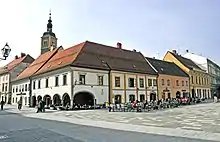
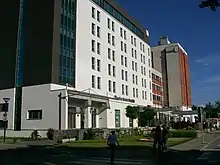
Varaždin is one of the few Croatian cities whose industry did not directly suffer from the war in 1991. Besides textile giant Varteks (Varaždin Textile), it also has nationally important food (Vindija), metal, and construction industries. The Information Technology and financial and banking sector as are well developed. Further economic development has been encouraged with the creation of a free investment zone.[5]
Today Varaždin is a tourist destination for the summer holidays. The city has numerous areas of interests ranging from cultural areas (reflected by many museums, galleries and theaters in the area), shopping centers in the downtown core, various sports and recreation facilities, also a rich history in cuisine. The close of the tourist season is marked by two annual festivals. The annual ŠpancirFest begins at the end of August and ends in September (lasts for 10 days). At this time the city welcomes artists, street performers, musicians and vendors for what is called "the street walking festival".
The city also hosts the Varaždin Baroque Evenings festival, first held in 1971. The festival honours baroque music and culture, both of which hold a special place in Varaždin's identity.
Varaždin is also the host of the Radar Festival, which hosts concerts at the end of summer. It has hosted artists like Bob Dylan, Carlos Santana, The Animals, Manic Street Preachers, Solomon Burke and others.[14][15]
Geothermal potential
In October 2023, the state-owned energy company, Bukotermal, announced the discovery of an underground lake of superheated water at an average 142 °C (288 °F), with the potential to support a 16MW geothermal power plant near the towns of Lunjkovec and Kutnjak.[16]
Transportation
Apart from A4 highway that runs between Zagreb and Goričan (Hungarian border), there are three state roads that reach the area of Varaždin: D2, D3 and D35. The town is fully encircled by the Varaždin bypass. Varaždin is also a hub for bus transportation company "AP Varaždin" which offers significant number of county (local), inter-county and inter-city services, also offering international lines.[17][18][19]
Varaždin's railway station is one of the largest and most important train stations in northern Croatia. It represents the intersection of three Croatian railway corridors that are used for both passenger and freight traffic - it lies on R201 railway (Zaprešić - Čakovec) and also represents the terminus for one local line (L201 connecting Golubovec) and one regional line (R202 connecting Dalj via Koprivnica, Virovitica and Osijek). All of the rail corridors that start, end or pass through Varaždin are single-tracked and non-electrified.
Sport

Varaždin is home to a number of professional and semi-professional sports clubs. Varaždin Arena, located near the Drava River, was one of the hosts of the 2009 World Men's Handball Championship held in Croatia.
- Football: NK Varaždin (1931–2015), NK Varteks (2011), NK Varaždin (2012)
- Handball: RK Varteks Di Caprio, RK Koka
- Basketball: KK Vindi
- Volleyball: OK Varaždin
- Tennis: TK Varaždin
- Baseball BK Vindija Varaždin
- KK Varteks
- Ice hockey: "KHL Varaždin"
- Wrestling: "Vindija"
- Water polo: "Coning"
- Badminton: "BK KAJ"
- Bicycling: "BD Sloga"
- Track and field: "TK Marathon 95"
Education
Schools
Varaždin has seven elementary schools, 10 high schools (2 public gymnasiums, 2 private gymnasiums, trade schools, and other specialized high schools for various paths). Varaždin 2 faculties (Faculty of Organization and Information Technology and Geotechnical faculty) that are part of the University of Zagreb and the University North.
Universities
There are 2 public universities currently operating in the city of Varaždin: Varaždin and Koprivnica took part in establishing the University North, a public national university that operates in both cities since 2015. University of Zagreb is present in the city with 2 displaced faculties from Zagreb itself.
Notable people

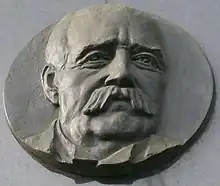
This list contains some of the notable people who were either born in Varaždin, lived in the city for a longer time or were in some significant way related to it.
- Ivan Belostenec – linguist, lexicographer[20]
- Slavko Brankov – actor
- Mirko Breyer – Croatian writer, bibliographer and antiquarian[21][22]
- Kristijan Đurasek – cyclist
- Baltazar Dvorničić Napuly – Catholic cleric and lawyer[23]
- Ignaz Grossmann (1825–1897), rabbi
- Juraj Habdelić – writer[24]
- Robert Herjavec – businessman, investor, and television personality
- Hermann II of Celje – count
- Saša Hiršzon (born 1972) - tennis player
- Branko Ivanković – football manager
- Luka Ivanušec – footballer
- Vatroslav Jagić – philologist, linguist
- Marija Jurić Zagorka – journalist, dramatist and novelist
- Ljubomir Kerekeš – actor
- Vjekoslav Klaić – writer and historian
- Ferdinand Konščak – explorer, cartographer
- Željko Krajan – tennis coach and former player
- Ivan Kukuljević Sakcinski – historian, politician, writer
- Maria Leitner - writer, journalist
- Samuel Louis Mosinger – businessman and member of the "Varaždin charity society"
- Miljenko Mumlek – footballer
- Robert Murić – footballer
- Ivan Padovec – guitar virtuoso
- Franjo Rački – historian, politician and writer
- Marko Rog – footballer
- Radoslav Rogina – cyclist
- Vjekoslav Rosenberg-Ružić – composer, conductor and music educator
- Silvester Sabolčki – footballer
- Tadija Smičiklas – historian and politician
- Ignacije Szentmartony – theologian
- Ksaver Šandor Gjalski – writer and civil servant
- Karolina Šprem – tennis player
- Krsto Ungnad – baron/mayor
- Željko Vincek – track and field athlete
- Davor Vugrinec – footballer
- Johann Baptist Wanhal – composer
Twin towns – sister cities
Varaždin is twinned with:[25][26]
 Bad Radkersburg, Austria
Bad Radkersburg, Austria Koblenz, Germany
Koblenz, Germany Montale, Italy
Montale, Italy Ptuj, Slovenia
Ptuj, Slovenia Ravensburg, Germany
Ravensburg, Germany.svg.png.webp) Schaffhausen, Switzerland
Schaffhausen, Switzerland Trnava, Slovakia
Trnava, Slovakia Zalaegerszeg, Hungary
Zalaegerszeg, Hungary
See also
Notes
- Register of spatial units of the State Geodetic Administration of the Republic of Croatia. Wikidata Q119585703.
- "Population by Age and Sex, by Settlements, 2021 Census". Census of Population, Households and Dwellings in 2021. Zagreb: Croatian Bureau of Statistics. 2022.
- "Population by Age and Sex, by Settlements, 2011 Census: Varaždin". Census of Population, Households and Dwellings 2011. Zagreb: Croatian Bureau of Statistics. December 2012.
- MacGregor, Sandra (4 February 2016). "Varazdin: Croatia's 'little Vienna'". Telegraph.
- "Varaždin County". ICPR3. Archived from the original on 3 December 2013. Retrieved 30 November 2013.
- "Hrvatski jezični portal - Varaždin". HJP.
- "Varaždin history". varazdin.hr. Archived from the original on 3 December 2013. Retrieved 30 November 2013.
- Goldstein & Goldstein 2001, p. 260.
- Croatian National Bank. Features of Kuna Banknotes Archived 6 May 2009 at the Wayback Machine: 5 kuna Archived 6 May 2009 at the Wayback Machine (1993 issue) & 5 kuna Archived 6 May 2009 at the Wayback Machine (2001 issue). – Retrieved on 30 March 2009.
- "The Varaždin Civil Guard 'Purgari'". Tourism-Varaždin.
- "International Children and Youth Animation Film Festival Varaždin". Archived from the original on 28 February 2013. Retrieved 28 April 2013.
- "Varaždin Climate Normals" (PDF). Croatian Meteorological and Hydrological Service. Retrieved 2 December 2015.
- "Mjesečne vrijednosti za Varaždin u razdoblju1949−2014" (in Croatian). Croatian Meteorological and Hydrological Service. Retrieved 3 December 2015.
- "Radar festival 2008: Bob Dylan, Manic Street Preachers, Majke, Drago Mlinarec & Vlado Kreslin" (in Croatian). Archived from the original on 29 April 2014. Retrieved 29 April 2014.
- "Radar festival: Santana, Solomon Burke, Eric Burdon and The Animals, Joe Jackson, Zoran Predin & Lačni Franz, Voodoo Lizards, Tripdavon" (in Croatian). Archived from the original on 29 April 2014. Retrieved 29 April 2014.
- Croatia wants to turn this superhot underground lake into a 16MW geothermal power plant - Countries across the EU are ramping up efforts to harness the Earth's heat, Siôn Geschwindt, TNW, 2023-10-11
- "Gospodarstvo". varazdin.hr (in Croatian). Retrieved 2 June 2022.
- "AP Varaždin". AP Varaždin (in Croatian). Retrieved 2 June 2022.
- "Povezivanje naselja autobusnim prometom u Varaždinskoj županiji" (PDF). zir.nsk.hr (in Croatian). 2018. Retrieved 27 March 2023.
- "Belostenec, Ivan" (in Croatian). Miroslav Krleža Institute of Lexicography. Retrieved 29 April 2014.
- Goldstein & Goldstein (2001, pp. 92, 172, 173, 174, 175, 176)
- Goldstein & Goldstein (2001, pp. 264, 265)
- "Dvorničić Napuly, Baltazar" (in Croatian). Miroslav Krleža Institute of Lexicography. Retrieved 29 April 2014.
- "Habdelić, Juraj" (in Croatian). Miroslav Krleža Institute of Lexicography. Retrieved 2 April 2014.
- "Varaždin i EU" (in Croatian). Varaždin. Retrieved 27 September 2021.
- "Povelja prijateljstva Varaždina i Schaffenhausa" (in Croatian). Varaždin. 25 June 2019. Retrieved 27 September 2021.
Sources
- Cresswell, Peterjon; Atkins, Ismay; Dunn, Lily (10 July 2006). Time Out Croatia (First ed.). London, Berkeley & Toronto: Time Out Group Ltd & Ebury Publishing, Random House Ltd. 20 Vauxhall Bridge Road, London SV1V 2SA. ISBN 978-1-904978-70-1. Retrieved 10 March 2010.
- Goldstein, Ivo; Goldstein, Slavko (2001). Holokaust u Zagrebu (in Croatian). Zagreb, Croatia: Novi liber. p. 260. ISBN 978-9-53604-519-8.
External links
- (in Croatian) varazdin.hr – Official website
- (in English) varazdin.hr/en – Official website
- Varaždin City Museum – official website
- eVarazdin.hr – daily city e-newspapers
- Varaždin Online — News from Varaždin, up-dated daily
- Varaždin Trg Kralja Tomislava Live
